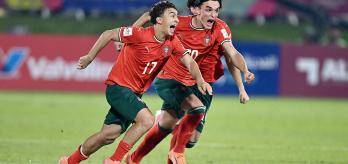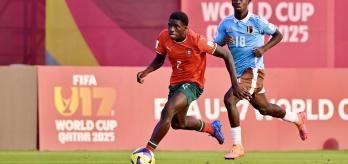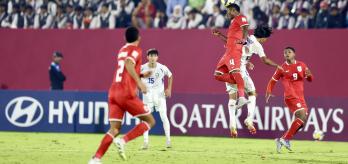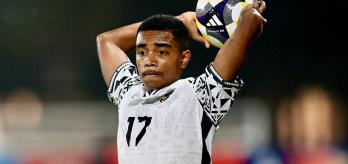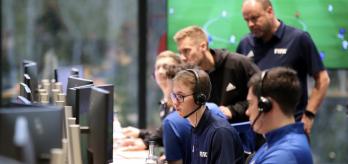It’s the first time a Portuguese team has competed in a World Cup at this age level since 2003, and head coach Bino Maçães’ side have consistently impressed our Technical Study Group (TSG) members since their opening group B victory against New Caledonia.
On their route to the final, the reigning UEFA U-17 European champions also beat Morocco, Belgium, Mexico and Switzerland, and will face Austria in the final, which will be played in the Khalifa International Stadium on Thursday, November 27th.
Key characteristics
According to FIFA TSG expert Louis Carey, this group of young players and their coaching staff represent all the best qualities of Portugal’s footballing DNA.
-
Excellent positional play and understanding of roles
-
Clever rotations and intentional filling of space
-
Players can play in different areas of the pitch and in different positions
-
Positive body position to receive, protect and progress the ball
-
Impressive technical passing qualities
-
Mindset to keep the ball from throw-ins and restarts
“Portugal are a really well-coached team. Their mentality is to play, and I love that. They have confidence and belief in each other, and play the game with fluidity and in the right spirit. Their body language shows they are confident, but they are not afraid to mix it up with physical teams and get up after a kick. Their players show clear levels of game awareness to see the situation in front of them, have the decision-making skills to know which pass to make, and the technique to execute those actions.
“Their defenders have speed and mobility, their midfielders can play off different levels with real intelligence and mutual understanding, while their forwards are light on their feet with balance, speed and explosive power and show a willingness to run in behind. The impact of their substitutes has also been impressive.”
Carey has selected clip 1 below to highlight the impressive way that individual players interact with both the ball and their opponents in tight spaces to retain and progress their possession.
In possession
As part of FIFA’s TSG for this tournament, former Republic of Ireland international Damien Duff has been impressed by Portugal’s setup in possession.
“In possession, Portugal are well-drilled and great at movements, and one of my key take-aways as a coach is that you need to move your opponents. Portugal are a team that stresses their opponents’ defensive structures. I like their patterns and love how their two defensive midfielders, Rafael Quintas (6) and Bernardo Lima (18), impact and dictate the game. They are cogs in the team — they disrupt the opposition, drop in with the centre-backs in build-up, drop out to the side to pull opposition players out of shape, and push high to create overloads in attacking areas.
“Portugal have explosive players in every unit who change the pace very quickly. They have mastered their rotations, and their forwards have a real appetite to run in behind.”
This observation is supported by the data provided by our Football Performance Insights Team, as Portugal are ranked in the top four for offers in behind the opposition’s defensive line per 60 minutes ball-in-play time. They also average 17.4 receptions in this territory (P60BIP).
Duff has selected clip 2 below as a great example of the positive in-possession traits that Portugal have demonstrated in the tournament to date.
“It starts with a throw-in and has 14 passes in the build-up to the goal, with seven outfield players touching the ball. The angles of support play and the speed at which they move the ball make this really difficult to defend. Despite the volume of player interactions and passes, it feels like a very fast goal.”
Out of possession
According to Simone Gomes Jatobá, “Portugal have a solid and confident defence, and they work really well as a unit. They are always aligned and can defend in different ways against different teams. They can adapt from using a back 4 to a back 5 seamlessly when the game demands it, particularly when their left winger Stevan Manuel (11) works very hard to drop in alongside his left-back when needed. Their centre-back, Mauro Furtado (4), is a true defender and reads the game very well. He can turn defence into attack.
“They don’t always press high — they like to defend from a mid-block and are patient in this structure, knowing when to wait and when to engage. Once their pressing triggers are activated, they are aggressive and defend well on the ground and in the air, based on what the scenario demands.”
Former FIFA Women’s World Cup™ runner-up, Jatobá, uses clip 3 below to highlight Portugal’s discipline without the ball.
“They are holding in a compact mid-block and showing their intent to defend the space initially and not the ball. Before the ball is played long, we can see how the midfielders have short lines to the defenders, who are in a 3v3 situation, and this is a quality trait in this team. The line of defence that is being stressed always has support from the next line. They all move together with strong communication between the players, and they are always so explosive in transitioning to attack when they win the ball back.
GOALKEEPER: Romário Cunha
As the TSG’s Goalkeeper Expert, Pascal Zuberbuhler, explains, “Although he did not play in the first match against New Caledonia, Romário Cunha has played all six of Portugal’s games since. As his team have dominated games, he has not been called into action as much as some other goalkeepers, but when needed by his team, he has been decisive and impactful, making six saves from on-target attempts at goal from inside his penalty area, and has saved five first-time attempts at goal.
“Despite not converting his penalty in the semi-final shoot-out against Brazil, he showed a lot of personality and mental strength. His concentration levels are high, and he stays present in the game. He commands his area well, is powerful in 1v1 situations and has good distribution, with the ability to mix it up with long and short passes.”







